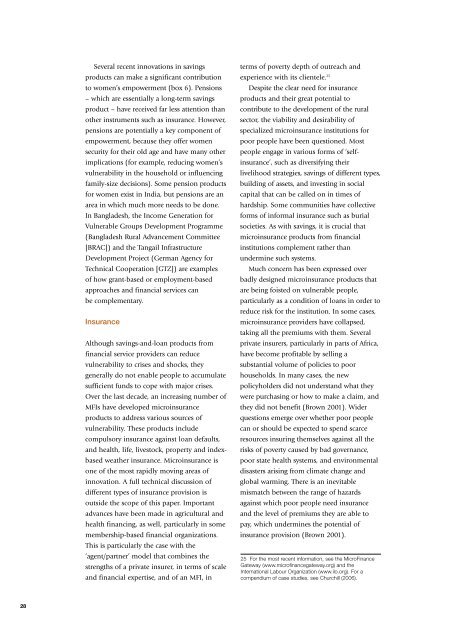Gender and rural microfinance: Reaching and empowering ... - IFAD
Gender and rural microfinance: Reaching and empowering ... - IFAD
Gender and rural microfinance: Reaching and empowering ... - IFAD
Create successful ePaper yourself
Turn your PDF publications into a flip-book with our unique Google optimized e-Paper software.
Several recent innovations in savings<br />
products can make a significant contribution<br />
to women’s empowerment (box 6). Pensions<br />
– which are essentially a long-term savings<br />
product – have received far less attention than<br />
other instruments such as insurance. However,<br />
pensions are potentially a key component of<br />
empowerment, because they offer women<br />
security for their old age <strong>and</strong> have many other<br />
implications (for example, reducing women’s<br />
vulnerability in the household or influencing<br />
family-size decisions). Some pension products<br />
for women exist in India, but pensions are an<br />
area in which much more needs to be done.<br />
In Bangladesh, the Income Generation for<br />
Vulnerable Groups Development Programme<br />
(Bangladesh Rural Advancement Committee<br />
[BRAC]) <strong>and</strong> the Tangail Infrastructure<br />
Development Project (German Agency for<br />
Technical Cooperation [GTZ]) are examples<br />
of how grant-based or employment-based<br />
approaches <strong>and</strong> financial services can<br />
be complementary.<br />
Insurance<br />
Although savings-<strong>and</strong>-loan products from<br />
financial service providers can reduce<br />
vulnerability to crises <strong>and</strong> shocks, they<br />
generally do not enable people to accumulate<br />
sufficient funds to cope with major crises.<br />
Over the last decade, an increasing number of<br />
MFIs have developed microinsurance<br />
products to address various sources of<br />
vulnerability. These products include<br />
compulsory insurance against loan defaults,<br />
<strong>and</strong> health, life, livestock, property <strong>and</strong> indexbased<br />
weather insurance. Microinsurance is<br />
one of the most rapidly moving areas of<br />
innovation. A full technical discussion of<br />
different types of insurance provision is<br />
outside the scope of this paper. Important<br />
advances have been made in agricultural <strong>and</strong><br />
health financing, as well, particularly in some<br />
membership-based financial organizations.<br />
This is particularly the case with the<br />
‘agent/partner’ model that combines the<br />
strengths of a private insurer, in terms of scale<br />
<strong>and</strong> financial expertise, <strong>and</strong> of an MFI, in<br />
terms of poverty depth of outreach <strong>and</strong><br />
experience with its clientele. 25<br />
Despite the clear need for insurance<br />
products <strong>and</strong> their great potential to<br />
contribute to the development of the <strong>rural</strong><br />
sector, the viability <strong>and</strong> desirability of<br />
specialized microinsurance institutions for<br />
poor people have been questioned. Most<br />
people engage in various forms of ‘selfinsurance’,<br />
such as diversifying their<br />
livelihood strategies, savings of different types,<br />
building of assets, <strong>and</strong> investing in social<br />
capital that can be called on in times of<br />
hardship. Some communities have collective<br />
forms of informal insurance such as burial<br />
societies. As with savings, it is crucial that<br />
microinsurance products from financial<br />
institutions complement rather than<br />
undermine such systems.<br />
Much concern has been expressed over<br />
badly designed microinsurance products that<br />
are being foisted on vulnerable people,<br />
particularly as a condition of loans in order to<br />
reduce risk for the institution. In some cases,<br />
microinsurance providers have collapsed,<br />
taking all the premiums with them. Several<br />
private insurers, particularly in parts of Africa,<br />
have become profitable by selling a<br />
substantial volume of policies to poor<br />
households. In many cases, the new<br />
policyholders did not underst<strong>and</strong> what they<br />
were purchasing or how to make a claim, <strong>and</strong><br />
they did not benefit (Brown 2001). Wider<br />
questions emerge over whether poor people<br />
can or should be expected to spend scarce<br />
resources insuring themselves against all the<br />
risks of poverty caused by bad governance,<br />
poor state health systems, <strong>and</strong> environmental<br />
disasters arising from climate change <strong>and</strong><br />
global warming. There is an inevitable<br />
mismatch between the range of hazards<br />
against which poor people need insurance<br />
<strong>and</strong> the level of premiums they are able to<br />
pay, which undermines the potential of<br />
insurance provision (Brown 2001).<br />
25 For the most recent information, see the MicroFinance<br />
Gateway (www.<strong>microfinance</strong>gateway.org) <strong>and</strong> the<br />
International Labour Organization (www.ilo.org). For a<br />
compendium of case studies, see Churchill (2006).<br />
28

















